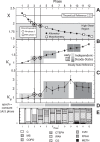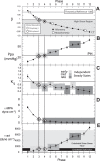Diverse forms of pulmonary hypertension remodel the arterial tree to a high shear phenotype
- PMID: 24858853
- PMCID: PMC4121648
- DOI: 10.1152/ajpheart.00144.2014
Diverse forms of pulmonary hypertension remodel the arterial tree to a high shear phenotype
Abstract
Pulmonary hypertension (PH) is associated with progressive changes in arterial network complexity. An allometric model is derived that integrates diameter branching complexity between pulmonary arterioles of generation n and the main pulmonary artery (MPA) via a power-law exponent (X) in dn = dMPA2(-n/X) and the arterial area ratio β = 2(1-2/X). Our hypothesis is that diverse forms of PH demonstrate early decrements in X independent of etiology and pathogenesis, which alters the arteriolar shear stress load from a low-shear stress (X > 2, β > 1) to a high-shear stress phenotype (X < 2, β < 1). Model assessment was accomplished by comparing theoretical predictions to retrospective morphometric and hemodynamic measurements made available from a total of 221 PH-free and PH subjects diagnosed with diverse forms (World Health Organization; WHO groups I-IV) of PH: mitral stenosis, congenital heart disease, chronic obstructive pulmonary lung disease, chronic thromboembolism, idiopathic pulmonary arterial hypertension (IPAH), familial (FPAH), collagen vascular disease, and methamphetamine exposure. X was calculated from pulmonary artery pressure (PPA), cardiac output (Q) and body weight (M), utilizing an allometric power-law prediction of X relative to a PH-free state. Comparisons of X between PAH-free and PAH subjects indicates a characteristic reduction in area that elevates arteriolar shear stress, which may contribute to mechanisms of endothelial dysfunction and injury before clinically defined thresholds of pulmonary vascular resistance and PH. We conclude that the evaluation of X may be of use in identifying reversible and irreversible phases of PH in the early course of the disease process.
Keywords: allometry; complexity; pulmonary hypertension.
Copyright © 2014 the American Physiological Society.
Figures




References
-
- Bennett SH, Eldridge M, Zaghi D, Zaghi S, Milstein J, Goetzman B. Form and function of fetal and neonatal pulmonary arterial bifurcations. Am J Physiol Heart Circ Physiol 279: H3047–H3057, 2000 - PubMed
-
- Bennett SH. Modeling methodology for vascular input impedance determination and interpretation. J Appl Physiol 75: 455–484, 1994 - PubMed
-
- Bennett SH, Goetzman BW, Milstein JM, Pannu JS. Role of arterial design on pulse wave reflection in a fractal pulmonary network. J Appl Physiol 80: 1033–1056, 1996 - PubMed
Publication types
MeSH terms
Grants and funding
LinkOut - more resources
Full Text Sources
Other Literature Sources
Medical

